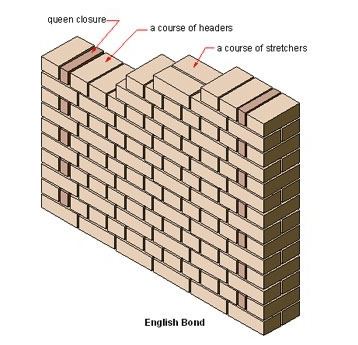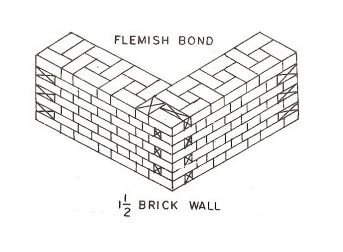English bond and Flemish bond are the two most common brick masonry patterns used in wall construction. They are classified based on laying and bonding style of bricks in walls. The bonds in brick masonry are developed by the mortar filling between layers of bricks and in grooves when bricks are laid adjacent to each other and in layers in walls. The most commonly used material for bonds in brick masonry is cement mortar. Lime mortar and mud mortar are also used.
Commonly used types of bonds in brick masonry are:
- English bond
- Flemish bond
- Header bond
- Stretcher bond
- Zigzag bond
- English cross bond
- Raking bond etc

English Bond
A brick construction pattern with alternate courses of brick laid as stretchers and header forms an English bond. Headers are laid centered on the stretchers in course and each alternate row is vertically aligned. To break the continuity of vertical joints, quoin closer is used in the beginning and end of a wall after first header. A quoin close is a brick cut lengthwise into two halves and used at corners in brick walls. An English bond can be constructed for almost all wall thickness. This bond is the strongest among all other bonds.

What You Need To Know About English Bond
- This bond consists of headers and stretchers laid in alternative courses.
- The middle portion of the thicker walls consists of headers.
- No strict supervision and skill required for construction of this bond.
- It provides rough appearance especially for one brick thick walls.
- There are no noticeable continuous vertical joints in the structure built in this bond.
- It is strongest of all the bonds.
- It is costly because the use of brick bats is not allowed.
- Less motor is used.
- Progress of work is more.
- For breaking vertical joints queen closer is placed after first header.
- The joints formed in the header course are greater (twice) than the stretcher course. Therefore, the joint in the header course is made thinner compared to the joints in the stretcher course.
Flemish Bond
A Flemish bond also referred to as Dutch bond, is a brick construction pattern created by laying alternate stretchers and headers in a single course. The next course of brick is laid such that header lies in the middle of the stretcher. Every alternate course of Flemish bond starts with header at the corner.
For breaking of vertical joints in the successive courses, closers are inserted in alternate courses next to the quoin header. However, in walls having their thickness equal to odd number of half bricks, bats are used to achieve the bond.
Flemish bonds can be classified as:
- Single Flemish Bond
- Double Flemish Bond

What You Need To Know About Flemish Bond
- This bond consists of headers and stretchers laid alternatively in each course.
- The walls with odd multiple of half brick employ half bats and three-quarter bats.
- Special attention and good workmanship is required in providing this bond.
- It provides good appearance for all thickness of walls.
- There are partly continuous vertical joints in the structure built in this bond.
- It is less strong for walls having thickness more than 13 ½ inches.
- It is economical because brick bats are allowed for forming this bind.
- More mortar is used due to use of bats.
- Progress of work is less.
- For breaking of vertical joints in the successive courses, closers are inserted in alternate courses next to the quoin header.
- The walls with even multiple of half bricks do not require bats.
Also Read: Difference Between I-Beam And H-Beam
Difference Between English Bond And Flemish Bond In Tabular Form
| BASIS OF COMPARISON | ENGLISH BOND | FLEMISH BOND |
| Description | This bond consists of headers and stretchers laid in alternative courses. | This bond consists of headers and stretchers laid alternatively in each course. |
| Walls | The middle portion of the thicker walls consists of headers. | The walls with odd multiple of half brick employ half bats and three-quarter bats. |
| Attention | No strict supervision and skill required for construction of this bond. | Special attention and good workmanship is required in providing this bond. |
| Appearance | It provides rough appearance especially for one brick thick walls. | It provides good appearance for all thickness of walls. |
| Continuous Vertical Joints | There are no noticeable continuous vertical joints in the structure built in this bond. | There are partly continuous vertical joints in the structure built in this bond. |
| Strength | It is strongest of all the bonds. | It is less strong for walls having thickness more than 13 ½ inches. |
| Cost | It is costly because the use of brick bats is not allowed. | It is economical because brick bats are allowed for forming this bind. |
| Quantity Of Motor | Less motor is used. | More mortar is used due to use of bats. |
| Progress Of Work | Progress of work is more. | Progress of work is less. |
| Vertical Joints | For breaking vertical joints queen closer is placed after first header. | For breaking of vertical joints in the successive courses, closers are inserted in alternate courses next to the quoin header. |
Conclusion
Flemish bonds have better appearance but are weaker than English bonds for load bearing wall construction. Thus, if the pointing has to be done for brick masonry walls, then Flemish bond may be used for better aesthetic view. If the walls have to be plastered, then it is better to use English bond.
Also Read: Difference Between One-Way And Two-Way Slab